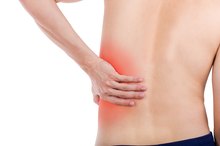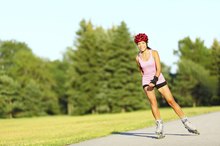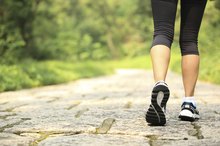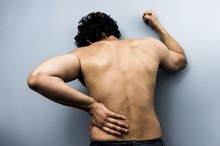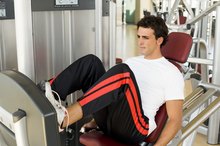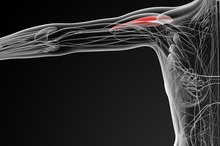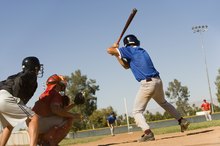My Lower Back Always Hurts After Basketball
Basketball represents an aerobic sport that offers a variety of health benefits, including enhanced bone strength and the power to burn calories quickly, but the sudden movements and jerking motions required by basketball often result in strains that cause lower back pain. While most back pain remedies include rest and non-prescription pain relievers, surgery might be needed in some cases to provide relief. Understand your options for lower back pain in order to ensure your well-being.
Basketball and Back Pain
Although most people suffer back pain at some point during life, an exercise regimen that includes high-impact sports like basketball elevates your risk for the condition. Your back contains a network of segments, including tendons, ligaments, bones and muscles. Disks in your back provide cushioning between your spine and the various segments. MayoClinic.com reports that sudden movements, such as those that occur numerous times during a typical basketball game, often disrupt one or more of the segments in your back and cause pain. Strained muscles or ligaments, which are more likely to occur during high-impact exercise, also are a common source of lower back pain.
- Although most people suffer back pain at some point during life, an exercise regimen that includes high-impact sports like basketball elevates your risk for the condition.
- MayoClinic.com reports that sudden movements, such as those that occur numerous times during a typical basketball game, often disrupt one or more of the segments in your back and cause pain.
Exercise for Endurance
Lower Back Pain and Skateboarding
Learn More
Low-impact aerobic methods often help prevent or relieve lower back pain by building strength and endurance in your back, which enhances muscle function. Aerobic exercise also aids weight loss, which can relieve pressure on your back. The American Academy of Orthopaedic Surgeons recommends riding a stationary bicycle or walking on a treadmill for up to 30 minutes on most days of the week with your doctor’s permission. Walking is light on your joints, while stationary riding limits stress on your back, as well as your ankles and knees. Swimming also is beneficial for those with back pain, since the buoyancy of water minimizes joint stress.
- Low-impact aerobic methods often help prevent or relieve lower back pain by building strength and endurance in your back, which enhances muscle function.
Back-Strengthening Activity
Trainers often suggest core exercise routines as an ideal method to strengthen the muscles in your back and lower your risk for injury during sports like basketball and tennis. Perform a bridge routine by lying on your back and bending your knees. Maintain a relaxed position and avoid arching or pressing your back against the carpet. Tighten the muscle inside your abdominal area and raise your hips from the ground until they are aligned with your shoulders and knees. Hold the raised stance for three deep breaths and relax. Aim to eventually perform 15 repetitions with your doctor’s permission.
- Trainers often suggest core exercise routines as an ideal method to strengthen the muscles in your back and lower your risk for injury during sports like basketball and tennis.
- Tighten the muscle inside your abdominal area and raise your hips from the ground until they are aligned with your shoulders and knees.
Potential
Mid-Back Pain That Comes & Goes
Learn More
Over-the-counter pain medicine with ibuprofen or acetaminophen often provides relief from minor back pain within a few weeks, as does an application of cold and hot pads to the source of discomfort. Your doctor might recommend a prescribed muscle relaxant for pain that persists. Some cases of back pain normalize after an injection of cortisone, or anti-inflammatory medicine. Surgery is an option when your pain is severe and accompanies leg pain or muscle weakness that worsens over time.
- Over-the-counter pain medicine with ibuprofen or acetaminophen often provides relief from minor back pain within a few weeks, as does an application of cold and hot pads to the source of discomfort.
Related Articles
References
- NBA.com: Sacroiliac Joint and Low Back Pain
- MayoClinic.com: Core Exercises
- American Academy of Orthopaedic Surgeons: Low Back Pain Exercise Guide
- Cleveland Clinic: What is the Best Aerobic Exercise?
- MayoClinic.com: Aerobic Exercise: Top 10 Reasons To Get Physical
- Deyo, R. Overtreating Chronic Back Pain: Time to Back Off? J Am Board Fam Med. Jan-Feb 2009.
- Low Back Pain Risk Factors Identified. American Academy of Orthopaedic Surgeons.
- Cherkin, D.C. (2016) Mindfulness-Based Stress Reduction vs Cognitive Behavioral Therapy. JAMA, 315(12), pp. 1240–1249. doi: 10.1001/jama.2016.2323.
- Deyo, R. Overtreating Chronic Back Pain: Time to Back Off? J Am Board Fam Med. Jan-Feb 2009.
Writer Bio
Toby Pendergrass began writing and editing in 1998. He has served as editor for numerous custom health publications and physician journals. His work has appeared in publications such as Hospital Corporation of America's "YOU." He enjoys writing about cardiology and cancer care and holds a Bachelor of Arts in communication from the University of Tennessee at Chattanooga.

